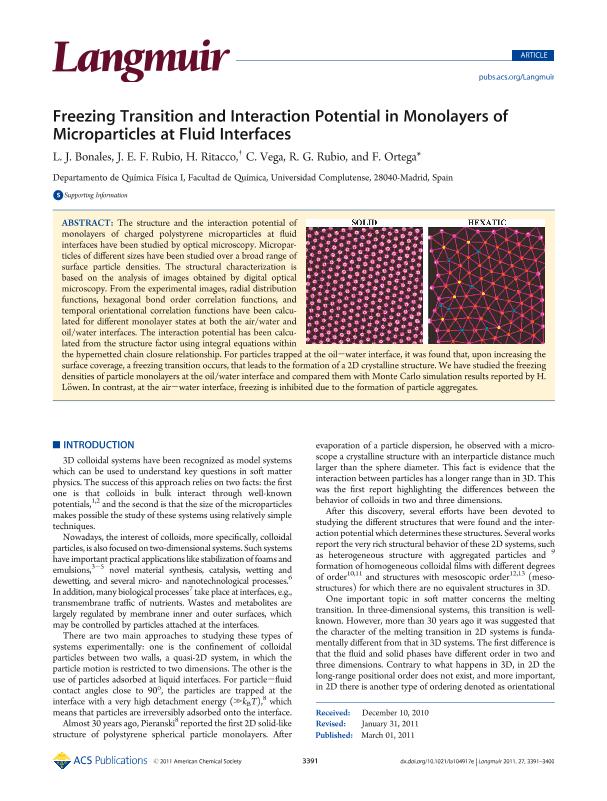Mostrar el registro sencillo del ítem
dc.contributor.author
Bonales, Laura J.
dc.contributor.author
Rubio, J. E. F.
dc.contributor.author
Ritacco, Hernán Alejandro

dc.contributor.author
Vega, C.
dc.contributor.author
Rubio, Ramón G.
dc.contributor.author
Ortega, Francisco

dc.date.available
2019-01-09T17:32:51Z
dc.date.issued
2011-04
dc.identifier.citation
Bonales, Laura J.; Rubio, J. E. F.; Ritacco, Hernán Alejandro; Vega, C.; Rubio, Ramón G.; et al.; Freezing transition and interaction potential in monolayers of microparticles at fluid interfaces; American Chemical Society; Langmuir; 27; 7; 4-2011; 3391-3400
dc.identifier.issn
0743-7463
dc.identifier.uri
http://hdl.handle.net/11336/67776
dc.description.abstract
The structure and the interaction potential of monolayers of charged polystyrene microparticles at fluid interfaces have been studied by optical microscopy. Microparticles of different sizes have been studied over a broad range of surface particle densities. The structural characterization is based on the analysis of images obtained by digital optical microscopy. From the experimental images, radial distribution functions, hexagonal bond order correlation functions, and temporal orientational correlation functions have been calculated for different monolayer states at both the air/water and oil/water interfaces. The interaction potential has been calculated from the structure factor using integral equations within the hypernetted chain closure relationship. For particles trapped at the oil-water interface, it was found that, upon increasing the surface coverage, a freezing transition occurs, that leads to the formation of a 2D crystalline structure. We have studied the freezing densities of particle monolayers at the oil/water interface and compared them with Monte Carlo simulation results reported by H. Löwen. In contrast, at the air-water interface, freezing is inhibited due to the formation of particle aggregates. © 2011 American Chemical Society.
dc.format
application/pdf
dc.language.iso
eng
dc.publisher
American Chemical Society

dc.rights
info:eu-repo/semantics/openAccess
dc.rights.uri
https://creativecommons.org/licenses/by-nc-sa/2.5/ar/
dc.subject
Particles at Interfaces
dc.subject
Ktnhy
dc.subject
Surface Phase Transitions
dc.subject.classification
Otras Ciencias Químicas

dc.subject.classification
Ciencias Químicas

dc.subject.classification
CIENCIAS NATURALES Y EXACTAS

dc.title
Freezing transition and interaction potential in monolayers of microparticles at fluid interfaces
dc.type
info:eu-repo/semantics/article
dc.type
info:ar-repo/semantics/artículo
dc.type
info:eu-repo/semantics/publishedVersion
dc.date.updated
2019-01-02T18:20:40Z
dc.journal.volume
27
dc.journal.number
7
dc.journal.pagination
3391-3400
dc.journal.pais
Estados Unidos

dc.journal.ciudad
Washington DC
dc.description.fil
Fil: Bonales, Laura J.. Universidad Complutense de Madrid; España
dc.description.fil
Fil: Rubio, J. E. F.. Universidad Complutense de Madrid; España
dc.description.fil
Fil: Ritacco, Hernán Alejandro. Universidad Complutense de Madrid; España. Consejo Nacional de Investigaciones Científicas y Técnicas. Centro Científico Tecnológico Conicet - Bahía Blanca. Instituto de Física del Sur. Universidad Nacional del Sur. Departamento de Física. Instituto de Física del Sur; Argentina
dc.description.fil
Fil: Vega, C.. Universidad Complutense de Madrid; España
dc.description.fil
Fil: Rubio, Ramón G.. Universidad Complutense de Madrid; España
dc.description.fil
Fil: Ortega, Francisco. Universidad Complutense de Madrid; España
dc.journal.title
Langmuir

dc.relation.alternativeid
info:eu-repo/semantics/altIdentifier/doi/https://dx.doi.org/10.1021/la104917e
dc.relation.alternativeid
info:eu-repo/semantics/altIdentifier/url/https://pubs.acs.org/doi/abs/10.1021/la104917e
Archivos asociados
